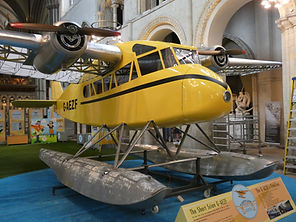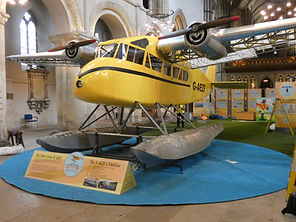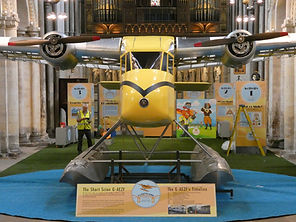
MEDWAY AIRCRAFT PRESERVATION SOCIETY Ltd
We restore and preserve historic aircraft and artefacts for public display.
Patron: Her Majesty The Queen
Short S.16 Scion II Floatplane G-AEZF
The Short Scion aircraft were designed by Short Brothers in 1933 as a small twin-engine, 4- to 6-seat passenger transport. 22 were built (1 prototype, 4 Mk I and 17 Mk II) and saw service in the UK, Australia and Palestine. The prototype flew on the scheduled service between Rochester to Southend for its first year.
G-AEZF was the last of six completed under licence by Pobjoy's at Rochester in 1937 and was a floatplane. It was purchased by Elders Colonial Airways for service in Sierra Leone. However, records show that it was never shipped, the contract probably being swapped with a Short Scion Senior, and languished in the hangar at Airport Works, Rochester until it was damaged by bombing in 1940. It was repaired, converted to a landplane and impressed to the war effort, suffering further damage and repair. After the war, it returned to civilian use and flew occasionally until about 1958.
After decommissioning, the aircraft initially stored at Redhill before being dumped behind a hangar at Southend and left to rot. In the mid 1990's, a local preservation team attempted to do some work to restore it; it was later moved back to Redhill. The remnants, comprising the fuselage frame, cockpit subframe, most of the port wing and half of the spar box of the starboard wing were purchased by MAPSL and brought to Rochester Airport on June 13, 2013. The restoration to museum standard has been continuing ever since, thanks to a substantial grant from The Rochester Bridge Trust and will become the flagship of MAPSL, Rochester Airport and Medway.
Current status
Short Scion II floatplane G-AEZF arrived at Rochester Airport on a low loader in June 2013 after being in storage for many years at Redhill Airport. Some restoration work had been undertaken by a small team while the aircraft was previously at Southend. The aircraft is now the subject of a long term restoration by MAPSL to a static condition and it is intended that it will eventually be sited on the airport as the flagship of the company. It is now beginning to look like a real aeroplane again with work progressing on the fuselage and the wings of this unique aircraft.
The fuselage has been fully restored from the basic frame and has been fabric covered prior to painting. From only a basic steel frame with duralumin cross members, the following elements have been constructed mainly from new, using similar materials and techniques to those used on the original aircraft.
-
Strengthening and repair of the frame including replacement cross-bracing.
-
Wooden upper and lower fairings which support the fabric covering.
-
Cabin with a carpeted floor, fabric covered walls and ceiling, wooden framed windows and internal furnishings.
-
Cockpit with a plywood skin fitted over over an ash frame, wooden framed windows and hatch fitted, refurbished or replacement controls, pilot's seat and instrument panel; the composite nose cone is being made.
-
Large rear window in the cabin replacing the access to the battery compartment, so that the construction within the rear fuselage can be viewed.
-
A replacement fully-operating empennage (fin and rudder, tailplane and elevator) with a refurbished pitch trim mechanism plus replacement pulleys and cables for the control runs.
Both wings have been completed and are partially fabric covered prior to painting, with replacement spars, refurbished and replacement cross bracing tubes and wires and replacement leading- and trailing-edges and wing tips plus replacement engine cowlings . Fabrication of the ailerons has yet to be completed.
A replica float has been fabricated, using the float borrowed from the Ulster Folk and Transport Museum in Belfast as a reference, from which a 3-D model was generated. The fabrication of the twelve float struts and a beaching trolley has also been completed. The floatplane was displayed throughout August 2025 in Rochester Cathedral, thanks to The Rochester Bridge Trust and their contractors.
Visitors are always welcome to view the progress on the Scion.
 |  |  |
|---|---|---|
 |  |  |
 |  |  |
 |  |  |
 |  |  |
 |  |  |
 |  |  |
Short Scion G-AEZF on display in Rochester Cathedral




